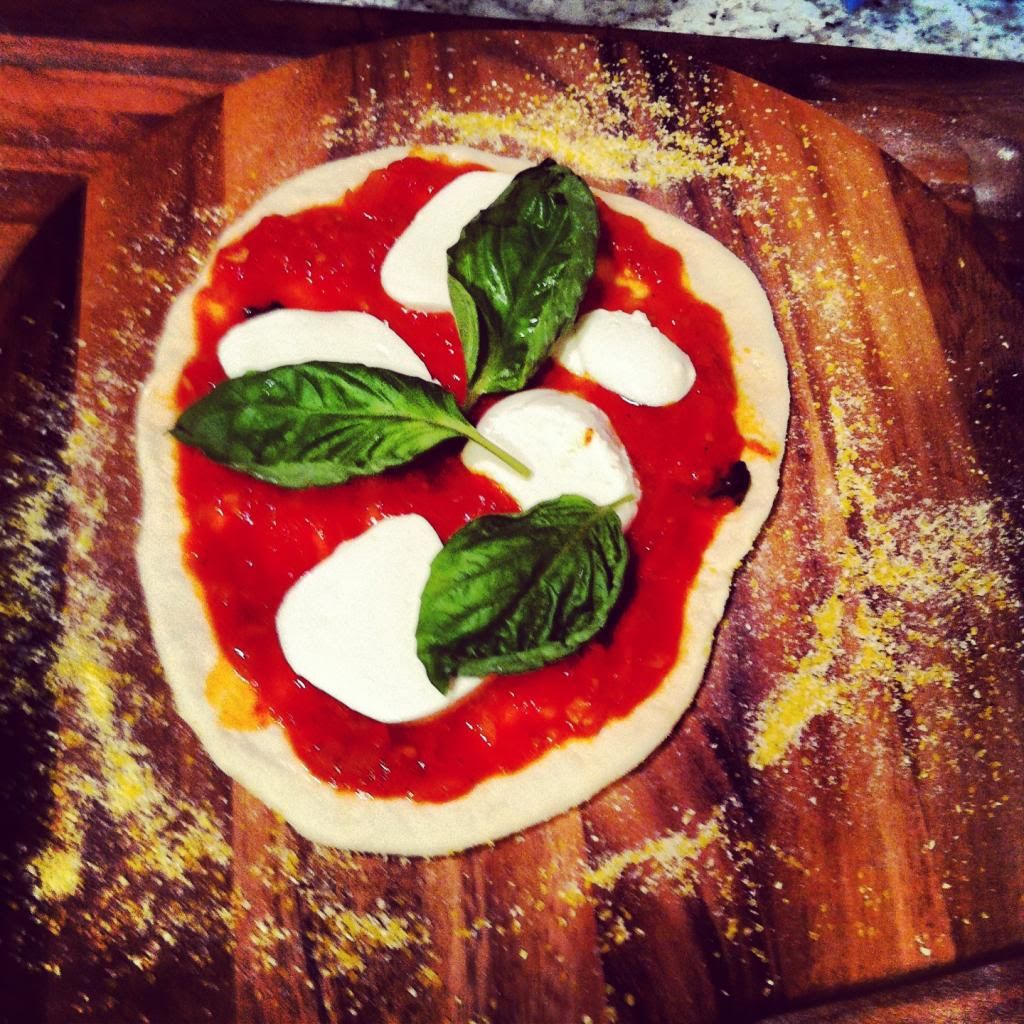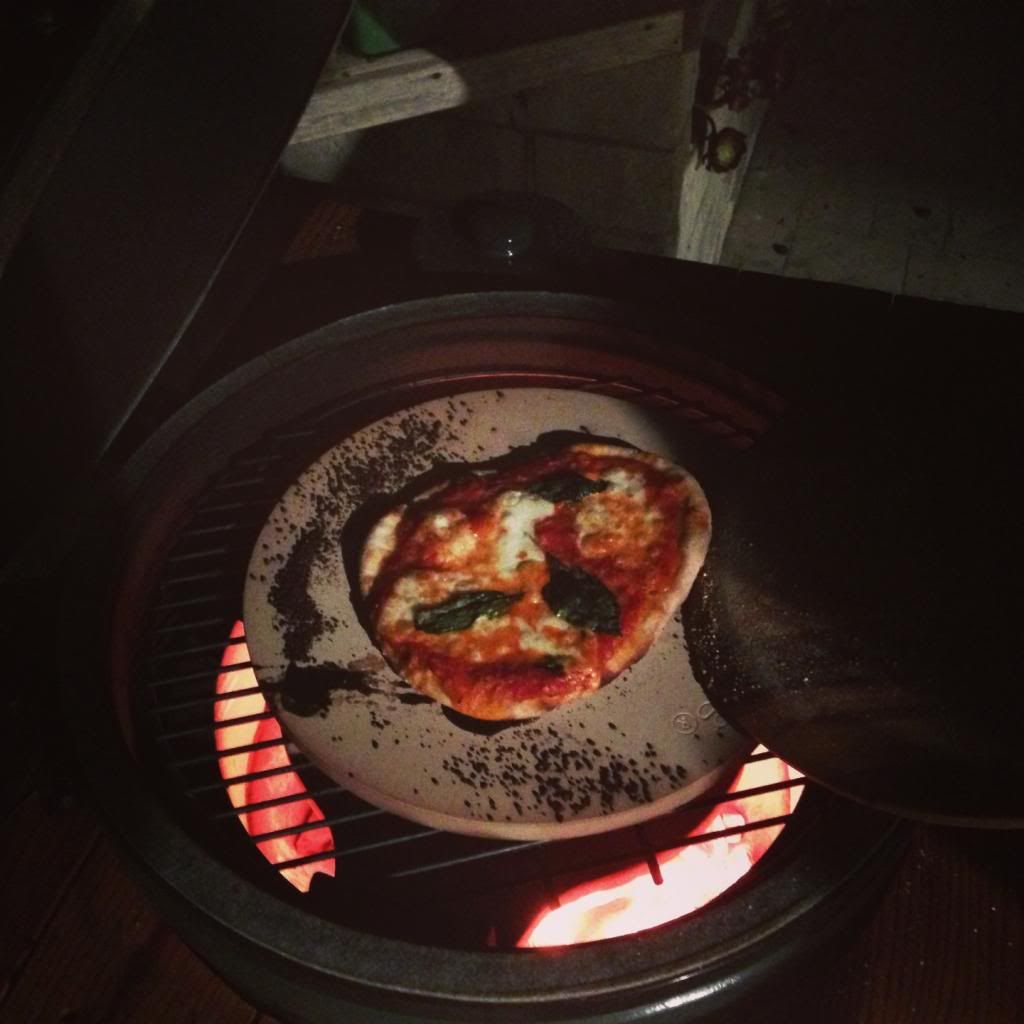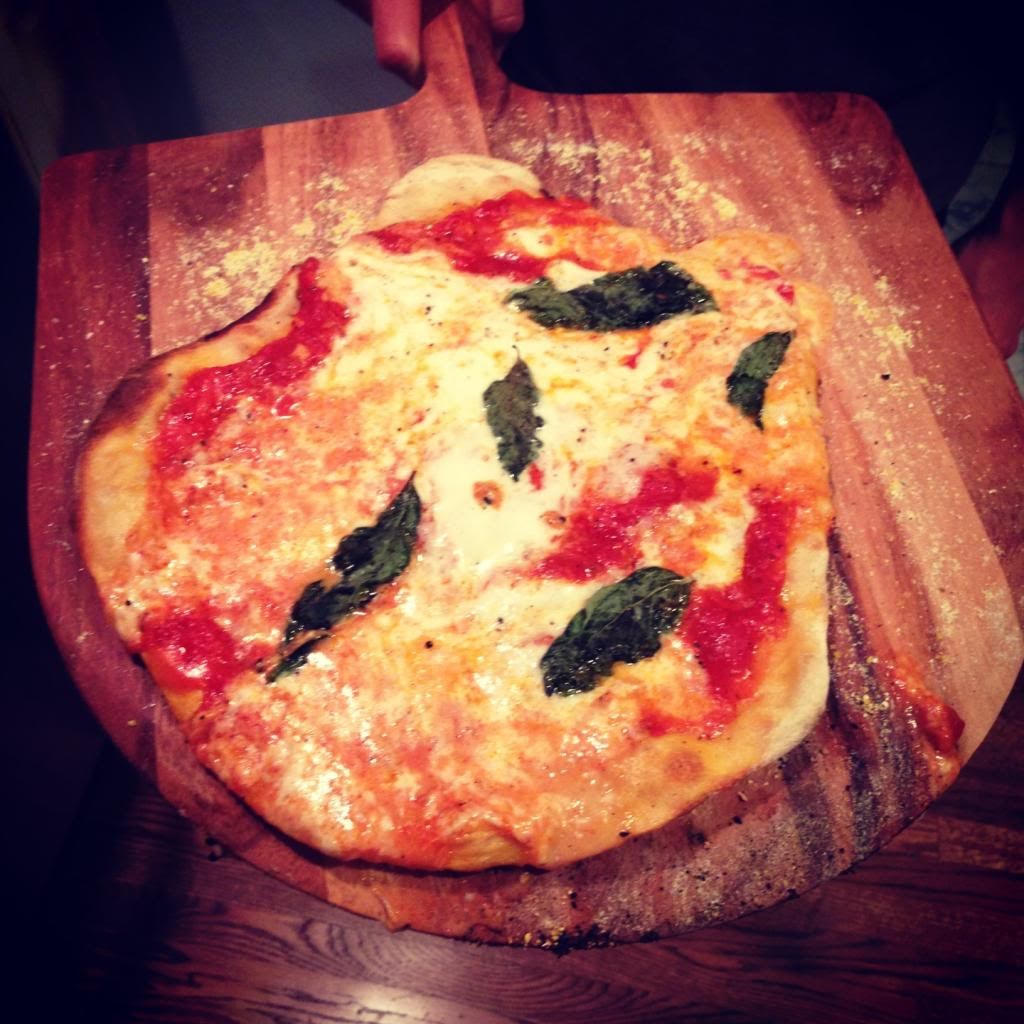Welcome to the EGGhead Forum - a great place to visit and packed with tips and EGGspert advice! You can also join the conversation and get more information and amazing kamado recipes by following Big Green Egg to Experience our World of Flavor™ at:
Want to see how the EGG is made? Click to Watch
Facebook | Twitter | Instagram | Pinterest | Youtube | Vimeo
Share your photos by tagging us and using the hashtag #BigGreenEgg.
Share your photos by tagging us and using the hashtag #BigGreenEgg.
Want to see how the EGG is made? Click to Watch
First Try Making Pizza - Photos and Questions

bicktrav
Posts: 640
Last night I tried making pizza in the egg for the first time. I followed a recipe for the dough I found here, and I used a Mario Batali recipe for the marinara. All in all, the pizza turned out really well. It was actually far better than I thought it would be given that it was my first go. Nonetheless, I did walk away with a few questions. Would love your help if you've got insights.



1) I was cooking the pizzas at 600. In the past when I've done high heat sears, I've had no trouble getting the egg to nuclear temperatures--800 degrees or beyond. But last night I had to open the bottom and top vents completely just to get to 600. It got there, but if I had wanted to go higher (which I may want to do in future pizza cooks) I wouldn't have been able to open any more vents to get the temperature to climb into the 700s or above. All the other times I've attempted really high temps, I've been cooking direct, so this is the first time I've tried high temps with the plate setter inside or the pizza stone. The only thing I can figure is that because the pizza stone and the plate setter were in there, they were making it harder for the temperature to climb. I was also wondering whether I may have needed to put more lump in. What do you think?
2) This relates to the first question: after cooking about three pizzas, the temp started to drop. I had the vents totally open, but I couldn't maintain 600. Instead, the temp fell to about 500. I still was able to get the fourth pizza cooked, but the drop in temp concerned me, especially given that the vents were totally open. Could this have been a function of burning through all the lump? Do you go through the lump ridiculously fast when you're cooking at those temps? For what it's worth, I put a healthy amount in. I didn't go all the way to the top of the fire ring or anything, but I did feel like there was a decent amount in there. Any thoughts?
3) Lastly, though the dough turned out very well, it wasn't quite as fluffy as I would have liked. The ideal pizza for me is one that has a billowing, blistered crust with some char on the outside, but some chew on the inside. This crust was very good, but it didn't have the char or chew I was looking for; instead, it was thinner with more of a cracker-ish consistency. Are the char and chew qualities a function of the temperature or the recipe for the dough or the amount of dough you're using (our dough was pretty thin for each pie), or is it a combo of all those factors? Has anyone accomplished a pizza with that kind of crust? Would love to hear tips. For what it's worth, the dough recipe I used can be found here: http://www.fornobravo.com/PDF/Using-caputo-tipo00.pdf
Alright, here are some photos. As I said, it turned out really well, but I'd love some help with the above questions so I can improve upon it next time.



Southern California
Comments
-
First: great-looking pie, especially for a first time!You definitely go through lump faster at higher temperatures. The hotter the fire, the faster it consumes its fuel. That might be part of the problem. With that said, I've done four pizzas with a fill just to the very top of the firebox in my Large, so I'm not convinced that you need to pour lump up into the fire ring to get this going.What I do is light in one spot in the center, bring the Egg up to a holding temp of about 450*, and crank the vents just before I put on the first pie. My wife and I work in tandem in the kitchen, so while I'm sliding the first pie off one peel, she's assembling the second pie on the other peel. That way, once you're at temp, you're working as quickly as you can.In service of quick work, I'd also recommend putting the pizza as high up in the dome as you can. I put the PS, legs up, the BGE tri-level rack, and the stone on top of the rack. The radiant heat from the dome means more even cooking, in my experience.Finally, I feel like the dough recipe we use might give you a little more of that "billowy" feel you're going for:Use all-purpose flour for this dough.Hope that helps! Just keep making pies and you'll eventually get a method that's perfect for you. Fewer Egg cooks are as variable in terms of people's personal tastes as pizza.[Northern] Virginia is for [meat] lovers.
-
Also, I definitely feel like pie master @jamieoro can be of some help to you, too.[Northern] Virginia is for [meat] lovers.
-
This is great info. Thanks for all the help! I'll give that dough recipe a try. I'll also try cooking higher up in the dome. Last night, I used two starter cubes to get the fire going. Maybe next time I'll use just one right in the center to preserve more of the lump. Practice makes perfect, so I'll keep going at it!SaturdayFatterday said:First: great-looking pie, especially for a first time!You definitely go through lump faster at higher temperatures. The hotter the fire, the faster it consumes its fuel. That might be part of the problem. With that said, I've done four pizzas with a fill just to the very top of the firebox in my Large, so I'm not convinced that you need to pour lump up into the fire ring to get this going.What I do is light in one spot in the center, bring the Egg up to a holding temp of about 450*, and crank the vents just before I put on the first pie. My wife and I work in tandem in the kitchen, so while I'm sliding the first pie off one peel, she's assembling the second pie on the other peel. That way, once you're at temp, you're working as quickly as you can.In service of quick work, I'd also recommend putting the pizza as high up in the dome as you can. I put the PS, legs up, the BGE tri-level rack, and the stone on top of the rack. The radiant heat from the dome means more even cooking, in my experience.Finally, I feel like the dough recipe we use might give you a little more of that "billowy" feel you're going for:Use all-purpose flour for this dough.Hope that helps! Just keep making pies and you'll eventually get a method that's perfect for you. Fewer Egg cooks are as variable in terms of people's personal tastes than pizza.Southern California -
For margarita, put basil on after it comes off. Residual heat will release oil in basil but will still be bright green.MBGE in Charleston
-
great tip-!finster said:For margarita, put basil on after it comes off. Residual heat will release oil in basil but will still be bright green.Proud resident of Missoula, MThttps://www.facebook.com/GrillingMontanahttp://grillingmontana.com
https://instagram.com/grillingmontana
Check out my book on Kamado cooking called Exclusively Kamado:
http://bit.ly/kamadobook -
Great tips above. The only other things I'd offer is to see how long you let the egg warm up after you put in the platesetter and stone. If you put them in cold, you're going to need a good bit of time for them to get up to temp of the egg (I put mine in 500 degree oven while egg is being lit and getting up to temp so it shortens time when putting them in cold). Also, assume you were using new lump? On re-used lump, my max temp is usually 500-600. Regarding your crust, I started out making pizzas with the same problem as you and it was how I was stretching the dough. Make sure to make a rim for the outside crust and do not touch or stretch the rim from there. Stretch from middle outward but don't disturb that outer rim. That should help you get a light fluffy crust. Best of luck...guaranteed they'll get better with time.San Antonio, TX
Categories
- All Categories
- 184K EggHead Forum
- 16.1K Forum List
- 461 EGGtoberfest
- 1.9K Forum Feedback
- 10.5K Off Topic
- 2.4K EGG Table Forum
- 1 Rules & Disclaimer
- 9.2K Cookbook
- 15 Valentines Day
- 118 Holiday Recipes
- 348 Appetizers
- 521 Baking
- 2.5K Beef
- 90 Desserts
- 167 Lamb
- 2.4K Pork
- 1.5K Poultry
- 33 Salads and Dressings
- 322 Sauces, Rubs, Marinades
- 548 Seafood
- 175 Sides
- 122 Soups, Stews, Chilis
- 40 Vegetarian
- 103 Vegetables
- 315 Health
- 293 Weight Loss Forum



